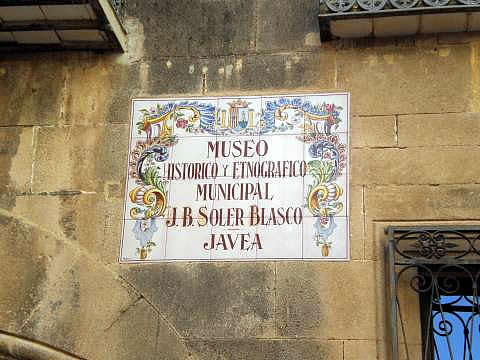|
This half hour documentary, which aired on 24th February features the museum of Xàbia, an interview with Director Ximo Bolufer and footage of the underwater excavations carried out in Portitxol bay. It follows a talk given to AMUX by archaeologist Alejandro Peréz on February 9th in which he described the great importance of Portitxol as an ancient and unique anchorage.
0 Comments
The first law regulating Spanish historical heritage was the Law of Excavations and Antiquities of 1911. There were other subsequent regulations until the drafting and approval of the Spanish Historical Heritage Law of 1985, which is still in force. In 1998 the Generalitat Valenciana approved the Llei del Patrimoni Cultural Valencià, a specific law for the Valencian Comunidad. Both the 1985 law and the Generalitat's regulation specify that all objects "coming from excavations, earthworks or works of any kind, or by chance" that were found on or under the ground or water, and that has any historical heritage value, are of public domain, and will be integrated in the Generalitat's patrimony.
In 1904 a menial labourer working on land in La Lluca belonging to Benissa resident Torres Orduña, hacked into a clay jar, bringing gold and silver jewelry to light. This was quite a sensation and became known at once as the Treasure of Javea. The owner of the land recognized that it was of immense historical value and offered it to the authorities of Valencia for an astronomical price. In Valencia, the pieces were identifed as being Iberian, most probably from the Fourth century BC. However they were not willing to pay such an outrageous price. Orduña then offered it to the National Archaeological Museum in Madrid, who also rejected it for the same reason. The French Government, who had already bought the statue of Dama de Elx at an earlier date, was very interested in acquiring this treasure too, and contacted Roque Chabás Lloréns, historian of Denia and archivist of the Cathedral of Valencia. Chabás wanted to keep the treasure in Spain and falsely told them that Madrid had already bought it. After further negotiations, Madrid finally did buy the treasure. And it has been exhibited there ever since. However, one necklace was missing from the collection : Orduña had donated this to the Purisima Chiqueta in Benissa, where it hung first in the Church of San Pere and was then transferred to the new church that we know today. In 1936, it disappeared from here during the Civil War, only to re-emerge in 1940 in Madrid. It had been offered and donated to the Museum to complete the collection. The gold jewellery displayed in the museum of Xàbia is a fine gold-plated copper copy, made by a Sevillian goldsmith F. Marmolejo. It was acquired by the Ayuntamiento of Xàbia in 1984. As you must already know, Xàbia now has two gold treasures to its name. Only last summer ( Aug. 2021 ) the second treasure - one of the largest sets of Roman gold coins found in Europe - was discovered in the Bay of Portitxol. This has good chances of finding its home in the Archaeological Museum of Xàbia……….but that´s a subject for another article, when more details have been released by the research team and the Conselleria……… ! |
ACTIVITIES
Categories |
- Home
- Blogs
-
Projectes
- Premio de Investigación - Formularios de Inscripción
-
Traducciones Translations
>
-
DISPLAY PANELS - GROUND FLOOR
>
- THE STONE AGES - PALAEOLITHIC, EPIPALAEOLITHIC AND NEOLITHIC
- CAVE PAINTINGS (ARTE RUPESTRE)
- CHALCOLITHIC (Copper) & BRONZE AGES
- THE IBERIAN CULTURE (THE IRON AGE)
- THE IBERIAN TREASURE OF XÀBIA
- THE ROMAN SETTLEMENTS OF XÀBIA
- THE ROMAN SITE AT PUNTA DE L'ARENAL
- THE MUNTANYAR NECROPOLIS
- ARCHITECTURAL DECORATIONS OF THE PUNTA DE L'ARENAL
- THE ATZÚBIA SITE
- THE MINYANA SMITHY
- Translations archive
- Quaderns: Versión castellana >
- Quaderns: English versions >
-
DISPLAY PANELS - GROUND FLOOR
>
- Catálogo de castillos regionales >
- Exposició - Castells Andalusins >
- Exposición - Castillos Andalusíes >
- Exhibition - Islamic castles >
- Sylvia A. Schofield - Libros donados
- Mejorar la entrada/improve the entrance >
-
Historia y enlaces
-
Historía de Xàbia
>
- Els papers de l'arxiu, Xàbia / los papeles del archivo
- La Cova del Barranc del Migdia
- El Vell Cementeri de Xàbia
- El Torpedinament del Vapor Germanine
- El Saladar i les Salines
- La Telegrafía y la Casa de Cable
- Pescadores de Xàbia
- La Caseta de Biot
- Castell de la Granadella
- La Guerra Civil / the Spanish civil war >
- History of Xàbia (English articles) >
- Charlas y excursiones / talks and excursions >
- Investigacions del museu - Museum investigations
- Enllaços
- Enlaces
- Links
-
Historía de Xàbia
>
- Social media
- Visitas virtuales
- Tenda Tienda Shop






 RSS Feed
RSS Feed
